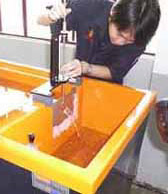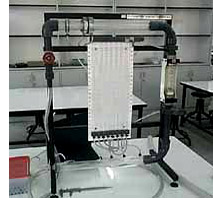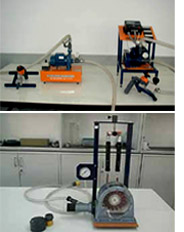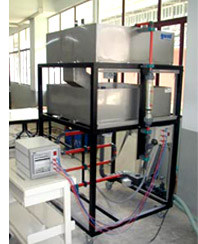Fluid Mechanic and Hydraulics Laboratory

The Fluid Mechanic and Hydraulic Laboratory provides supports to both undergraduate and graduate teaching so that students have the opportunity to see by themselves the essential fluid mechanics and hydraulic engineering principles, and to verify the applicability of various assumptions, models and analysis methods. It also provides facilities for researches in hydraulics, fluid mechanics and related fields to support graduate studies. Thus much of the fundamental research in the laboratory is comprised of thesis investigations.

The laboratory is well equipped with apparatus for research, practices, applications and demonstration of theories in fluid mechanics and hydraulic engineering subjects. The lab consists of open channel flume that is used to demonstrate such principles as critical depth, hydraulic jumps, controls, weir flow, and sluice gates. A number of sophisticated measurement tools are available including manometers, pitot tubes, and verniers for accurate depth measurements. Students are able to observe the hydraulic principles in real life, take measurements associated with the relevant governing equations, and thus verify for themselves that the equations correctly describe the principles. The Laboratory is located at first floor of new civil laboratories building.
Students have the opportunity to see by themselves the essential fluid mechanics and hydraulic engineering principles, and to verify the applicability of various assumptions, models and analysis methods

The concern theories, laboratory equipment and apparatus with experimental topics are listed below:


Fundamental Theories: Bernoulli’s Theorem Demonstration Apparatus – Demonstration of Bernoulli’s Theorem and its limitations. Direct measurement of the static and total head distribution along a Venturi tube. Determination of the meter coefficient at various flow rates. Flow Visualization Channel – Demonstration of the basic phenomena associated with open channel flow. Visualization of flow patterns (streamlines, pathlines and streaklines) over or around immersed objects. Hydrostatic Pressure Apparatus – Determination of the center of pressure on both a submerged or partially submerged plane surface and comparison with the theoretical center of pressure. Impact of Jet Apparatus – Measurement of the force exerted on different targets and comparison with the forces predicted by momentum theory.

Pipe flows: Osborne Reynolds’ Apparatus – Demonstration of the laminar, transitional, turbulent water flow and velocity profile. Pipe Friction Apparatus – Investigation of the variation of friction head along a circular pipe with the mean flow velocity in the pipe and the effects of laminar and turbulent flow regimes. Losses In Bends Apparatus – Measurement of the minor losses due to bends and angles in a pipe system. Hydraulic Ram Apparatus – Demonstration of the water ram (hammer) effects.

Hydraulic Machinery: Centrifugal Pump Demonstration Unit – Demonstration of single-stage centrifugal water pump in operation; measurement of inherent speed pump performance, including production of characteristic curves of flow rate against pump total head, motor input power, impeller speed, overall total efficiency, estimated impeller power & efficiency; introduction to pump speed laws. Series/Parallel Pumps Demonstration Unit – Demonstration of either series, parallel or single pump operation; comparison of head-flow characteristics with single pump operation, at inherent speed. Water Turbine Demonstration Unit – Measurement of turbine performance in terms of torque, brake power and efficiency as a function of runner speed.

Flow Measurement: Basic Weirs (v-notch, rectangular notch, etc) – Demonstration of characteristics of flow over weirs; determination of flow rate and coefficient of discharge. Flowmeter Demonstration Apparatus – Direct comparison of flow measurement using a Venturi Meter, Variable Area Meter and Orifice Plate. Orifice and Jet Apparatus – Determination of the coefficient of discharge for a small orifice with flow under constant head and flow under varying head; comparison of the measured trajectory of a jet with that predicted by simple theory of mechanics. Orifice Discharge Apparatus – Determination of the contraction and velocity coefficients; calculation of discharge coefficients.

Open Channel Flow: Multi-Purpose Teaching Flume – Studies of various open channel flow phenomena, e.g. hydraulic jump, flow over crump weir, sharp crested weir, broad crested weir, venturi flume, sluice gate and false floor, etc. Wave Generation System – Generation of simple progressive sinusoidal waves within the Multi-Purpose Flume for studies of free surface water waves. Water Tank – water tank equipped with a pneumatic controlled stainless steel partition for fundamental researches in fluid mechanics, such as mixing process of density driven current, wave to runup transition process, etc.

Hydrology: Basic Hydrology System – Investigation of rainfall/run flood hydrographs. Studies of ground water abstraction and fluvial mechanics.